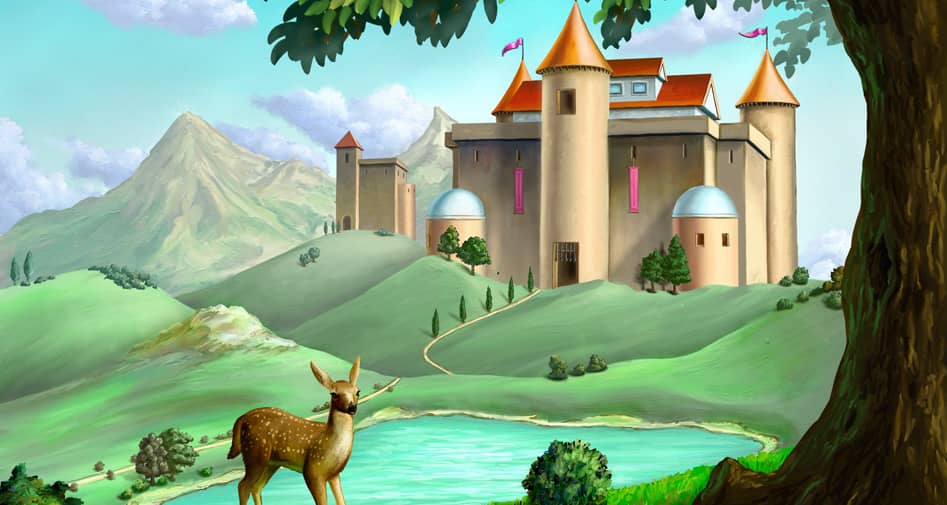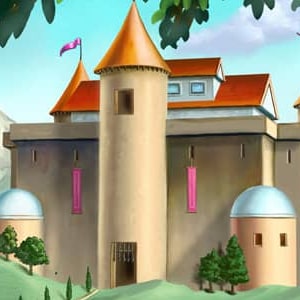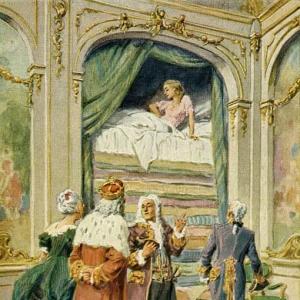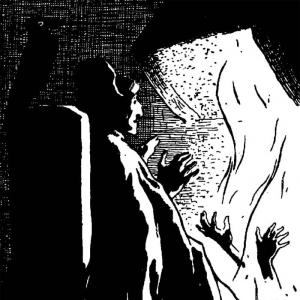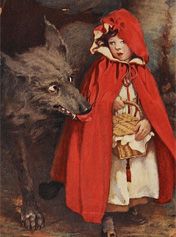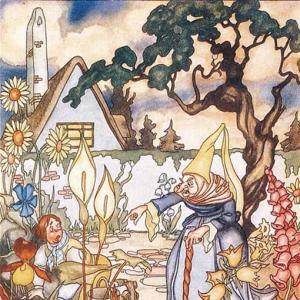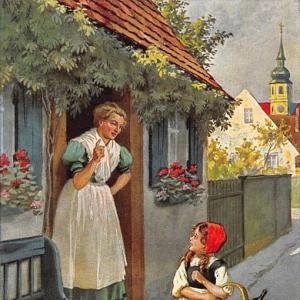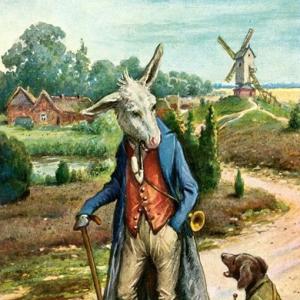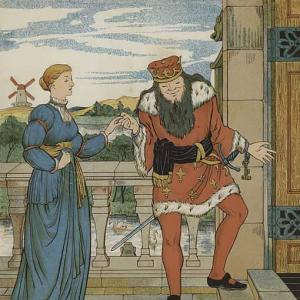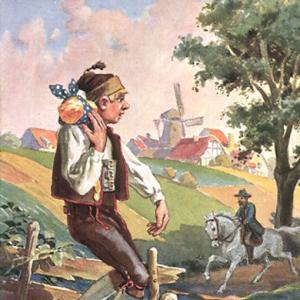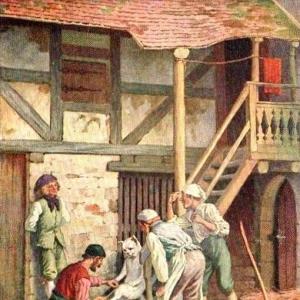Reading time for children: 3 min
In the winter time, when deep snow lay on the ground, a poor boy was forced to go out on a sledge to fetch wood. When he had gathered it together, and packed it, he wished, as he was so frozen with cold, not to go home at once, but to light a fire and warm himself a little. So he scraped away the snow, and as he was thus clearing the ground, he found a tiny, gold key. Hereupon he thought that where the key was, the lock must be also, and dug in the ground and found an iron chest. If the key does but fit it! thought he, no doubt there are precious things in that little box. He searched, but no keyhole was there. At last he discovered one, but so small that it was hardly visible. He tried it, and the key fitted it exactly. Then he turned it once round, and now we must wait until he has quite unlocked it and opened the lid, and then we shall learn what wonderful things were lying in that box.
 Learn languages. Double-tap on a word.Learn languages in context with Childstories.org and Deepl.com.
Learn languages. Double-tap on a word.Learn languages in context with Childstories.org and Deepl.com.Backgrounds
Interpretations
Adaptions
Summary
Linguistics
„The Golden Key“ is a short fairy tale collected by the Brothers Grimm, who were German academics, linguists, and cultural researchers known for their work compiling and publishing folk tales during the 19th century. Jacob and Wilhelm Grimm were part of the German Romantic movement, which sought to preserve and study traditional folk culture.
The Brothers Grimm published their first collection of fairy tales, „Children’s and Household Tales“ (Kinder- und Hausmärchen), in 1812. The collection underwent several revisions and expansions, ultimately resulting in over 200 stories in the final edition published in 1857. The tales in the collection were sourced from oral and written folk traditions, and the Grimm brothers‘ work played a significant role in preserving these stories for future generations.
„The Golden Key“ is one of the shorter tales in the collection and stands out due to its open-ended conclusion, which invites readers to use their imagination to interpret the meaning and outcome of the story. This aspect of the tale has made it a subject of discussion and analysis, as different readers can draw their own conclusions about the story’s meaning based on their personal experiences and perspectives.
„The Golden Key“ is an open-ended fairy tale, which allows for multiple interpretations depending on the reader’s perspective. Here are some possible interpretations of the story.
The Power of Curiosity and Imagination: The boy’s curiosity leads him to search for a lock after finding the golden key, which in turn takes him on a journey to discover the iron chest. The story invites the reader to share in the boy’s sense of wonder, as both the boy and the reader are left to imagine the possible treasures contained within the chest.
The Nature of Human Desire: The boy’s discovery of the key and his subsequent search for the chest may represent the human tendency to seek out and desire the unknown. Even though the boy has no idea what’s inside the iron chest, he’s driven to unlock it, illustrating the inherent human desire to pursue and possess the mysterious and unknown.
A Lesson in Patience and Anticipation: The tale’s open-ended conclusion leaves readers in suspense, teaching a lesson in patience as they must wait for the boy to finish unlocking the chest. This element of the story could be interpreted as a reminder to appreciate the process of discovery and the excitement that comes with anticipation.
The Potential for Transformation: The golden key might symbolize the potential for change, growth, or transformation in one’s life. By finding the key and unlocking the chest, the boy may be opening up new opportunities and possibilities for his future.
The Unpredictability of Life: The discovery of the golden key and the iron chest could be seen as a metaphor for the unexpected twists and turns that life can take. The boy stumbles upon the key by chance, demonstrating that life’s surprises and opportunities can appear when we least expect them.
„The Golden Key“ has been adapted into various forms of media, including literature, film, and theatre. Here are some notable adaptations:
„The Golden Key“ by George MacDonald: Scottish author George MacDonald adapted „The Golden Key“ in his 1867 book of fairy tales. MacDonald added his own twists to the story, including a character named Mossy who helps the protagonist find the key.
„The Golden Key“ by Ruth Sanderson: American children’s book author Ruth Sanderson published a picture book adaptation of „The Golden Key“ in 1996. The book features stunning illustrations and a faithful retelling of the original story.
„The Golden Key“ by Ludmilla Zeman: Canadian author Ludmilla Zeman adapted „The Golden Key“ into a series of illustrated books for children. Zeman’s version of the story includes additional characters and subplots, but stays true to the spirit of the original tale.
„The Golden Key“ by Philip Pullman: English author Philip Pullman adapted „The Golden Key“ as a stage play in 2006. Pullman’s version of the story adds more depth to the characters and explores themes of love, friendship, and sacrifice.
„The Golden Key“ by Wim Wenders: German filmmaker Wim Wenders directed a film adaptation of „The Golden Key“ in 2013. The film, which was shot in 3D, follows a young girl who embarks on a journey to find the key that will unlock the door to a magical world.
These adaptations demonstrate the enduring popularity of „The Golden Key“ and its ability to inspire new creative works across different forms of media.
„The Golden Key“ is a short fairy tale by the Brothers Grimm that takes place during the winter when deep snow covers the ground. The story follows a poor boy who ventures out on a sledge to gather wood. After collecting the wood, he decides to light a fire to warm himself before heading home. While clearing the snow to make space for his fire, the boy discovers a tiny, golden key.
Believing that there must be a lock nearby to match the key, the boy digs in the ground and uncovers an iron chest. He becomes excited, imagining that the chest contains precious treasures. However, he struggles to find a keyhole in the chest. After careful examination, he finally spots a nearly invisible keyhole and tries the golden key. To his delight, it fits perfectly.
The boy turns the key to unlock the chest, and the tale ends on a cliffhanger, leaving the reader in suspense about the contents of the mysterious iron box. The story concludes by suggesting that we must wait until the boy finishes unlocking the chest and opens the lid to reveal the wonderful things inside.
The Brothers Grimm’s tale „The Golden Key“ is a brief but intriguing story that invites a deeper linguistic analysis.
Here are some key elements to consider
Narrative Structure: The tale is concise and follows a straightforward narrative arc characteristic of fairy tales: introduction, discovery, anticipation, and an open-ended conclusion. This structure supports the story’s function as a parable or moral lesson, encouraging readers to contemplate the themes and their implications beyond the text.
Language and Tone: The language is simple and direct, typical of Grimm fairy tales, aimed at accessibility for audiences, including children. The tone is one of curiosity and wonder, enhanced by the discovery of the golden key and the mysterious chest. The repetitive use of „and“ suggests a progressive unfolding of events, heightening anticipation.
Symbolism
The Golden Key: Symbolizes opportunity, hope, or potential. Gold traditionally represents value and rarity, suggesting that what the key can unlock is significant.
The Iron Chest: Represents mystery and the unknown. Iron, being a strong material, suggests something well-protected, adding to the anticipation of discovery.
Winter Setting: Symbolizes hardship and adversity. The boy’s struggle against the cold mirrors the challenges one must face before finding opportunities (the key) or achieving success.
Themes
Curiosity and Discovery: The boy’s actions emphasize human curiosity and the desire to explore the unknown.
Potential and Possibility: The open-ended conclusion leaves the story with potential, inviting readers to imagine what the chest contains and the possibilities it represents.
Engagement with the Reader: The tale directly invites readers to anticipate „what wonderful things“ might be found, thereby engaging their imagination and prompting them to become an active part of the story’s conclusion.
Ambiguity and Open-Endedness: The story’s conclusion is deliberately left unresolved. This ambiguity encourages interpretation and reflection, making the tale a philosophical meditation rather than a mere narrative.
Overall, „The Golden Key“ functions not just as a story but as a metaphorical exploration of hope, curiosity, and the unknown, using simple language and symbols to provoke thought and engagement.
Information for scientific analysis
Fairy tale statistics | Value |
|---|---|
| Number | KHM 200 |
| Aarne-Thompson-Uther-Index | ATU Typ 2260 |
| Translations | DE, EN, ES, PT, IT, JA, NL, KO, PL, RU, TR, VI, ZH |
| Readability Index by Björnsson | 27.1 |
| Flesch-Reading-Ease Index | 87.9 |
| Flesch–Kincaid Grade-Level | 5.6 |
| Gunning Fog Index | 8.9 |
| Coleman–Liau Index | 6.3 |
| SMOG Index | 8 |
| Automated Readability Index | 5.5 |
| Character Count | 906 |
| Letter Count | 691 |
| Sentence Count | 10 |
| Word Count | 184 |
| Average Words per Sentence | 18,40 |
| Words with more than 6 letters | 16 |
| Percentage of long words | 8.7% |
| Number of Syllables | 218 |
| Average Syllables per Word | 1,18 |
| Words with three Syllables | 7 |
| Percentage Words with three Syllables | 3.8% |
